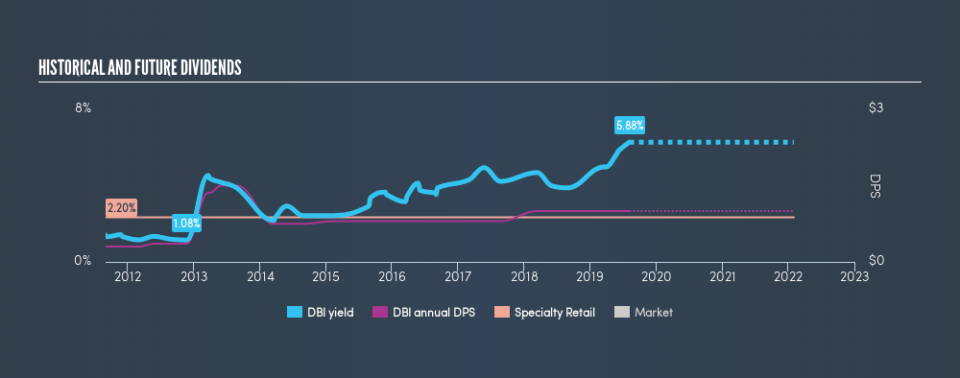Should Designer Brands Inc. (NYSE:DBI) Be Part Of Your Income Portfolio?

Is Designer Brands Inc. (NYSE:DBI) a good dividend stock? How can we tell? Dividend paying companies with growing earnings can be highly rewarding in the long term. On the other hand, investors have been known to buy a stock because of its yield, and then lose money if the company's dividend doesn't live up to expectations.
With a eight-year payment history and a 5.9% yield, many investors probably find Designer Brands intriguing. It sure looks interesting on these metrics - but there's always more to the story . The company also bought back stock during the year, equivalent to approximately 9.6% of the company's market capitalisation at the time. When buying stocks for their dividends, you should always run through the checks below, to see if the dividend looks sustainable.
Explore this interactive chart for our latest analysis on Designer Brands!
Payout ratios
Companies (usually) pay dividends out of their earnings. If a company is paying more than it earns, the dividend might have to be cut. Comparing dividend payments to a company's net profit after tax is a simple way of reality-checking whether a dividend is sustainable. Although Designer Brands pays a dividend, it was loss-making during the past year. When a company is loss-making, we next need to check to see if its cash flows can support the dividend.
Designer Brands paid out 105% of its free cash flow last year, suggesting the dividend is poorly covered by cash flow.
Is Designer Brands's Balance Sheet Risky?
Given Designer Brands is paying a dividend but reported a loss over the past year, we need to check its balance sheet for signs of financial distress. A rough way to check this is with these two simple ratios: a) net debt divided by EBITDA (earnings before interest, tax, depreciation and amortisation), and b) net interest cover. Net debt to EBITDA measures total debt load relative to company earnings (lower = less debt), while net interest cover measures the ability to pay interest on the debt (higher = greater ability to pay interest costs). With net debt of 0.44 times its EBITDA, Designer Brands has an acceptable level of debt.
We calculated its interest cover by measuring its earnings before interest and tax (EBIT), and dividing this by the company's net interest expense. Designer Brands has interest cover of more than 12 times its interest expense, which we think is quite strong.
Remember, you can always get a snapshot of Designer Brands's latest financial position, by checking our visualisation of its financial health.
Dividend Volatility
From the perspective of an income investor who wants to earn dividends for many years, there is not much point buying a stock if its dividend is regularly cut or is not reliable. Looking at the last decade of data, we can see that Designer Brands paid its first dividend at least eight years ago. It's good to see that Designer Brands has been paying a dividend for a number of years. However, the dividend has been cut at least once in the past, and we're concerned that what has been cut once, could be cut again. During the past eight-year period, the first annual payment was US$0.30 in 2011, compared to US$1.00 last year. This works out to be a compound annual growth rate (CAGR) of approximately 16% a year over that time. Designer Brands's dividend payments have fluctuated, so it hasn't grown 16% every year, but the CAGR is a useful rule of thumb for approximating the historical growth.
Designer Brands has grown distributions at a rapid rate despite cutting the dividend at least once in the past. Companies that cut once often cut again, but it might be worth considering if the business has turned a corner.
Dividend Growth Potential
Given that the dividend has been cut in the past, we need to check if earnings are growing and if that might lead to stronger dividends in the future. Designer Brands's earnings per share have shrunk at 30% a year over the past five years. A sharp decline in earnings per share is not great from from a dividend perspective, as even conservative payout ratios can come under pressure if earnings fall far enough.
Conclusion
To summarise, shareholders should always check that Designer Brands's dividends are affordable, that its dividend payments are relatively stable, and that it has decent prospects for growing its earnings and dividend. It's a concern to see that the company paid a dividend despite reporting a loss, and the dividend was also not well covered by free cash flow. Unfortunately, the company has not been able to generate earnings per share growth, and cut its dividend at least once in the past. In this analysis, Designer Brands doesn't shape up too well as a dividend stock. We'd find it hard to look past the flaws, and would not be inclined to think of it as a reliable dividend-payer.
Without at least some growth in earnings per share over time, the dividend will eventually come under pressure either from costs or inflation. See if the 8 analysts are forecasting a turnaround in our free collection of analyst estimates here.
Looking for more high-yielding dividend ideas? Try our curated list of dividend stocks with a yield above 3%.
We aim to bring you long-term focused research analysis driven by fundamental data. Note that our analysis may not factor in the latest price-sensitive company announcements or qualitative material.
If you spot an error that warrants correction, please contact the editor at editorial-team@simplywallst.com. This article by Simply Wall St is general in nature. It does not constitute a recommendation to buy or sell any stock, and does not take account of your objectives, or your financial situation. Simply Wall St has no position in the stocks mentioned. Thank you for reading.

